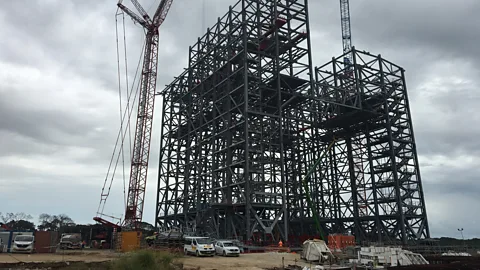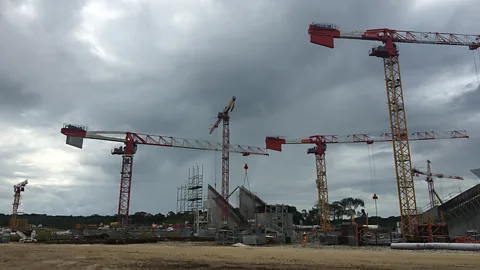The rocket tower being built in tropical jungle

 Esa
EsaEurope’s new rocket launch tower is being built – but it’s a long way from the continent itself. BBC Future visit this ‘Eiffel Tower’ being built in the South American jungle.
To get the best view of the vast European spaceport at Kourou in French Guiana, you have to climb a steep hill through tropical jungle. It’s a strenuous and, frankly, sweaty hike. But that’s not the worst of it.
At the top, the trees give way to a roofed wooden observation deck with ‘Casa Araignées’ (‘House of Spiders’) scrawled on a board above the entrance. Everywhere you look there are hand-sized spiders, their webs stretched across the wooden beams.
Only if you pick your way carefully past them (the thought of getting entangled in a giant spider’s web is truly terrifying), can you see the landscape below and, dotted across the cleared jungle, the launch towers for Europe’s three rockets: Ariane 5, Soyuz and Vega.
The largest of these, Ariane 5, has been flying since 1996 and – despite a spectacularly catastrophic maiden mission – has proved to be the world’s most consistently reliable way to launch satellites into orbit and beyond. An Ariane 5 recently carried the giant BepiColombo spacecraft on the first stage of its long journey to Mercury. It’s also launched some of the world’s largest telecommunications, weather and navigation satellites.
You might also like:
But hitching a ride on an Ariane doesn’t come cheap. It costs somewhere in the region of $100m (£78m) to launch a satellite on Ariane 5 (the exact costs are rarely disclosed). Recent entrants to the market such as Elon Musk’s SpaceX promise the same service for tens of millions of dollars less.
In response, Europe is building Ariane 6 - a 62m-high (204ft), multi-stage rocket, capable of launching medium and large spacecraft into a variety of different orbits. With its 2.4bn euro (£2.14bn/$2.74bn) development funded by the European Space Agency (Esa), everything about the new launcher is designed to be cheaper and more efficient than Ariane 5.
 Richard Hollingham
Richard Hollingham“We’re aiming to make something that will be very attractive in terms of price and service to customers,” says Charlotte Beskow, head of Esa in Kourou, who readily admits cost isn’t the only factor. “We also have the political will to have our own independent access to space, if we don’t have our own European launchpad then we will always be dependent on others.”
Fitted with upgraded engines and new solid boosters, Ariane 6 will come in the equivalent of regular and supersized versions, depending on the mass and orbital destination of the payload. It’s also getting a brand new launchpad and gantry – a structure the French engineers working on the project affectionately describe as a “moveable Eiffel Tower”, albeit a boxy, modernistic version.
At the moment, the 90m-high (297ft) gantry is just a giant framework of girders, but in the coming months it will be covered in metal panels and the interior fitted with decks to encase the rocket. Unlike its predecessor Ariane 6 will be put together horizontally in a nearby building, before being hoisted-up into the launch tower for final assembly, fuelling and testing. Then, a few hours before launch, the whole structure will be moved away on rails to leave the rocket exposed on the launch pad.
“It’s what we did in the old days for Ariane 4 and it’s what we do for Vega and Soyuz, so it’s a proven technology,” says Beskow. “This time we’re doing it on a bigger scale but in terms of preparing the launcher, it’s quicker, it’s more efficient, it allows people to work in safe conditions and also from a weather point of view, it’s more convenient.”
Launching from the equator – where the Earth is spinning faster than other latitudes – helps give rockets an extra boost to orbit. The downside is the tropical climate; every building at the spaceport is under continuous attack from the forest. Their exteriors are streaked green with algae, moss and mould. As a result, the inside of the launch tower will be air-conditioned and encircled by lightning conductors to protect the rocket and, more importantly, the team of engineers working on it.
 Richard Hollingham
Richard HollinghamIt currently takes 35 days to prepare an Ariane 5 for launch. The rockets have to be hauled between different facilities on an extensive rail network, so the boosters and satellites can be added. With Ariane 6 the aim is to cut that time to just 12 days.
“The final product will be very simple, very streamlined, it will look elegant – that’s how we’re going to save time,” says Beskow. “There will be fewer manipulations, fewer operations, they’ll be less transport and so fewer bottlenecks – it should offer quicker turnaround times, quicker ways into space.”
But constructing a new launch gantry is only part of the engineering challenge. The most impressive engineering is below ground. On the surface, the launchpad will resemble an apron of steel and concrete but, once complete, its support structure will reach some 30m (100ft) beneath the soil. Either side, a pair of 20m-wide (66ft) tunnels have been built to funnel the flames from the exhaust and carry the water that’s sprayed at the rocket during launch.
“We call it the deluge – we throw lots of water on it, so it reduces the vibrations on the launcher and the payload,” Beskow explains. “It also reduces the toxic fallout, so it’s very important.”
Right now, this latest European launch complex is a vast construction site with 600 workers employed here across two shifts. As I watch, seven high spindly cranes swing beams, concrete and rubble above me, sparks fly as technicians weld girders together and there is the constant pounding of pile drivers.
But, with the first Ariane 6 due off the production line in 2019 and the first launch planned for 2020, time is running short. Nevertheless, engineer in charge, Frédéric Munos, exudes a quiet confidence. After all, this is his fifth launchpad.
 Richard Holingham
Richard Holingham“We just have to do it right, properly, with good design and no accidents,” says Munos, matter-of-factly. “We’ll be satisfied when we see the first launch, watched by the eyes of the world.”
Earlier this year, when SpaceX launched its Falcon Heavy from the Kennedy Space Center in Florida, thousands of people travelled to see the launch. Because French Guiana is relatively isolated, comparatively few will ever witness, in person, the launch of an Ariane 6. But that’s something that Beskow also hopes to change.
“The trouble is because it’s in an ideal location, it’s also in a remote location – what I’d love to see is more people coming here just to see it, just as people go to Houston and Kennedy,” she says. “This is a European asset and it will be jaw-dropping to see.”
If you do decide to visit, just remember one thing: watch out for the giant spiders.
If you liked this story, sign up for the weekly bbc.com features newsletter, called “If You Only Read 6 Things This Week”. A handpicked selection of stories from BBC Future, Culture, Capital, and Travel, delivered to your inbox every Friday.
